The puzzle is presented with a preamble:
“Each of them traveled from city to city in a continuous path, and no one revisited a city on their journey. Kali began her journey first, and ended it last, in a city that had also been visited by another traveler. Laal started his journey last, while Bhura was in Bombay and Kali was in Calcutta, but he made his way to Calcutta before anyone else moved again. And Bhura was in Karachi while Kali was in Lahore. Below is some information about the cities that they visited, with * denoting a starting city.”
What follows is a set of tickets each containing a clue to a city in India (c. 1911, though some of the clues are anachronistic). Solvers can identify some, if not all, of the cities from the clues as presented.
At some point, though, solvers will need to recognize that what is being described here is a game of Ticket to Ride, being played on the India map. There are numerous clues to this: the puzzle title, the tickets, the set of cities described. “Chand” is the Hindi word for “moon,” and Alan Moon is the designer of Ticket to Ride. The puzzle also makes use of the standard resistor color code, mapping colors to numbers, in several ways (hinted at by the colors and “Resistance” in the flavortext and obliquely by the Om (ohm) watermarks on the tickets).
The names of the three players—Kali, Bhura, and Laal—are the Hindi words for black, brown, and red, respectively (and their names are written in these colors when they first appear). We are using the trains from Ticket to Ride: 10th Anniversary, where the usual yellow trains are replaced by brown trains, so these are the train colors for this game (additional clues to this: in the Anniversary edition, the black trains are little coal cars, the brown trains have a pair of large barrels, and the red trains are circus trains with cute little giraffes peeking out of the top).
Although the puzzle describes a legal (if somewhat illogical) game, it doesn’t describe any of the game features besides laying down trains to claim routes; the drawing of train cards and destination tickets, and all scoring, is skipped and not relevant to solving here.
The tickets shown each contain a clue to one of the cities on the Ticket to Ride India map, along with the names of those players who visited that city. Solvers need to solve the clues to figure out the set of cities visited by each player. They can then use the resistor colors as an index to extract a letter from each city described by a ticket in the order presented.
The table below shows the cities, as well as the ticket color, index, players who visited, and extracted letter.
| # | Letter | City | Clue | Ticket Color | Index | Kali | Bhura | Laal |
|---|---|---|---|---|---|---|---|---|
| 1 | P | RAIPUR | First-letter change of a city visited by Laal | yellow | 4 | |||
| 2 | L | WALTAIN | Should really end with an R | orange | 3 | |||
| 3 | E | ERODE | An English verb | brown | 1 | |||
| 4 | A | KATNI | A fictional archer without the last two (identical) letters | red | 2 | |||
| 5 | S | BILASPUR | Famous for Dubraj rice | green | 5 | |||
| 6 | E | BAREILLY | Naked and espresso brand | yellow | 4 | |||
| 7 | L | AMBALA | Found inside a Cajun dish | green | 5 | |||
| 8 | O | ROHRI | [Photo of Landsdowne + Ayub bridges] | red | 2 | |||
| 9 | O | BHOPAL | Capital of a namesake state once ruled by four begums | orange | 3 | |||
| 10 | K | KHANDWA | Hometown in the movie Lion | brown | 1 | |||
| 11 | A | AGRA | Home to one of the New Seven Wonders of the World | brown | 1 | |||
| 12 | T | RATIAM | Yoda's admission to being an informant | orange | 3 | |||
| 13 | O | QUILON | Cashew Capital of the World | green | 5 | |||
| 14 | N | MANGALORE | A male, a female, and something you find in a vein | orange | 3 | |||
| 15 | L | CALCUTTA | Connected to seven cities. Bhura arrived by ferry, Kali left by ferry, Laal just passed through | orange | 3 | |||
| 16 | Y | BOMBAY | Sounds like a compartment on a B-52 | blue | 6 | |||
| 17 | T | JARHAT | Headgear for a Marine? | blue | 6 | |||
| 18 | H | CHITTAGONG | Rhymes with something a percussionist might do | red | 2 | |||
| 19 | E | BEZWADA | Has tallest Hanuman statue in the world in its suburbs | red | 2 | |||
| 20 | O | JACOBABAD | Twin city of Esauabad? | yellow | 4 | |||
| 21 | D | AHMADABAD | The longest univocalic city | green | 5 | |||
| 22 | D | JODHPUR | [Photo of jodhpurs] | orange | 3 | |||
| 23 | L | CALICUT | State whose capital is Sacraford? | orange | 3 | |||
| 24 | E | LAHORE | [Photo of Lahore fort] | blue | 6 | |||
| 25 | N | GUNTAKAL | Only inland city connected to cities on both coasts | orange | 3 | |||
| 26 | G | MORMUGAU | Owned by Portugal in 1911 | blue | 6 | |||
| 27 | T | BHATINDA | Another name for this city is an anagram of BRAIN DEATH | yellow | 4 | |||
| 28 | H | KARACHI | Birthplace of US Senator from an eastern state | blue | 6 | |||
| 29 | R | DHUBRI | Where Assamese magicians hurled a 26-foot stone at a guru | green | 5 | |||
| 30 | O | POONA | Original name for an Olympic sport, whose rules were first drawn up here | red | 2 | |||
| 31 | U | JAIPUR | [Photo of Amer Fort] | green | 5 | |||
| 32 | T | PATNA | Green film on metal with one letter missing | orange | 3 | |||
| 33 | E | DELHI | Birthplace of US Senator from a western state | red | 2 | |||
| 34 | S | MADRAS | [image of madras fabric] | blue | 6 |
The extracted letters spell the message: PLEASE LOOK AT ONLY THE ODD LENGTH ROUTES.
Now, using the information that players moved from city to connected city (which is not required by the rules of Ticket to Ride) along with information on the tickets, solvers can work out the unique sequence of routes taken by each player.
The table below shows the set of cities visited by each player, along with the color and length of the routes linking each city. (It also shows the order in which these cities are visited; more on how to determine that information below.)
| BLACK (Kali) | BROWN (Bhura) | RED (Laal) | |||||||||
|---|---|---|---|---|---|---|---|---|---|---|---|
| city | color | lng. | ord. | city | color | lng. | ord. | city | color | lng. | ord. |
| Ahmadabad | green | 1 | 1 | Poona | grey | 1 | 2 | Bhatinda | violet | 2 | |
| Ratiam | grey | 2 | Mormugau | red | 2 | Rohri | black | 3 | 4 | ||
| Khandwa | blue | 2 | Guntakal | grey | 2 | Karachi | orange | 3 | 5 | ||
| Bhopal | grey | 2 | Mangalore | violet | 4 | Jodhpur | red | 2 | |||
| Bilaspur | yellow | 4 | Madras | grey | 8 | Jaipur | violet | 2 | |||
| Calcutta | grey | 2 | Calcutta | blue | 4 | Delhi | orange | 2 | |||
| Chittagong | grey | 3 | 6 | Raipur | orange | 4 | Agra | green | 2 | ||
| Jarhat | grey | 2 | Khandwa | yellow | 2 | Katni | grey | 2 | |||
| Dhubri | blue, red | 2 | Ahmadabad | white | 3 | 3 | Patna | violet | 2 | ||
| Patna | green | 4 | Bombay | grey | 6 | Calcutta | red | 4 | |||
| Bareilly | white | 1 | 7 | Karachi | white | 4 | Waltain | orange, black | 2 | ||
| Delhi | grey | 2 | Jacobabad | red | 3 | 8 | Bezwada | blue | 2 | ||
| Ambala | black | 4 | Lahore | Guntakal | white | 2 | |||||
| Lahore | grey | 2 | Madras | orange, green | 2 | ||||||
| Bhatinda | green | 3 | 9 | Erode | grey | 4 | |||||
| Jodhpur | Quilon | grey | 2 | ||||||||
| Calicut | grey | 6 | |||||||||
| Bombay | |||||||||||
Now solvers know the exact sequence of routes traversed by each player. Note that solvers need to observe the rule that in a two- or three-player game, only one player may claim each double-route. They clearly do not have enough information to determine how these interleave to form the exact order in which the routes were traversed in the game, but they do have some information from Mr. Chand’s preamble that will allow us to fix the order for the odd-length routes.
Each odd-length route will have a pair of colors associated with it: the color of the claiming train (black, brown, red--corresponding to 0, 1, 2 in the resistor code) and the color of the route itself. Note that the routes on the map are almost the same as the resistor-code colors, except that there are no brown routes. Solvers need to figure out that they need to interpret the train/route colors as two-digit numbers (via the resistor code), and then convert those numbers into standard alphabetic indices (01 = A, 02 = B, . . . 26 = Z).
Now solvers can map out the development of the game to sequence the odd-length routes. We begin with an empty board:
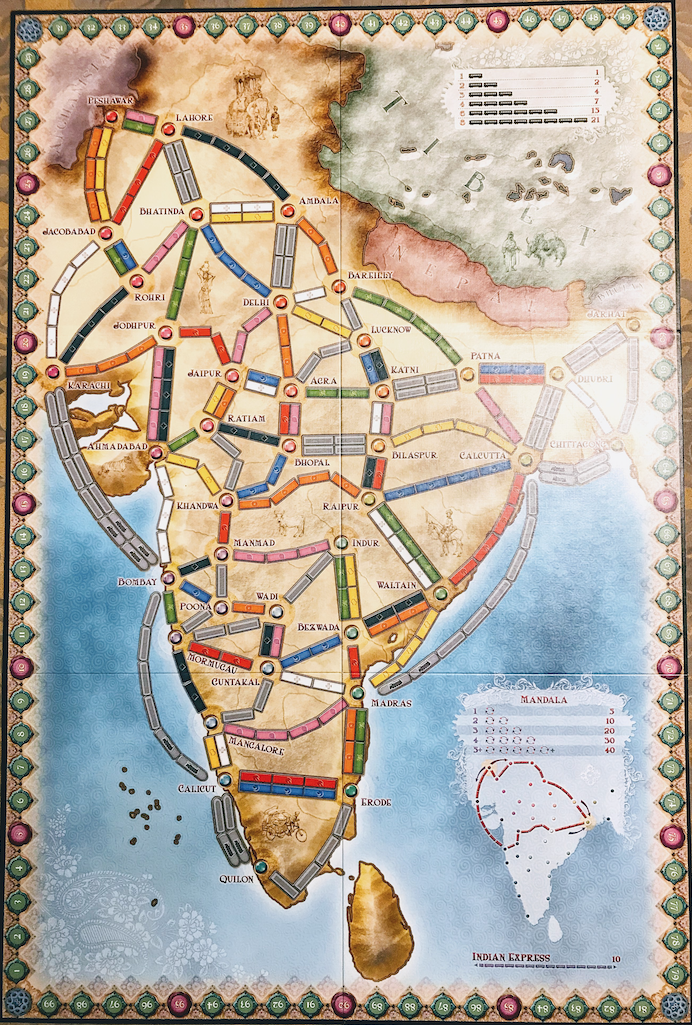
We know Kali (black) makes the first move, starting at Ahmadabad and moving to Ratiam:
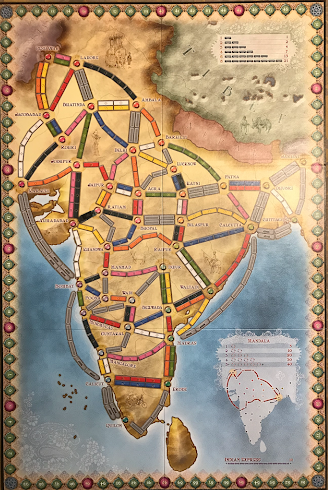
This is an odd-length route, so a black train on a green route specifies 05, yielding E.
Bhura (brown) moves second, going from Poona to Mormugau. We know Laal hasn’t moved yet, and we don’t exactly now where Kali is, but we do know that she hasn’t gone past Calcutta yet.
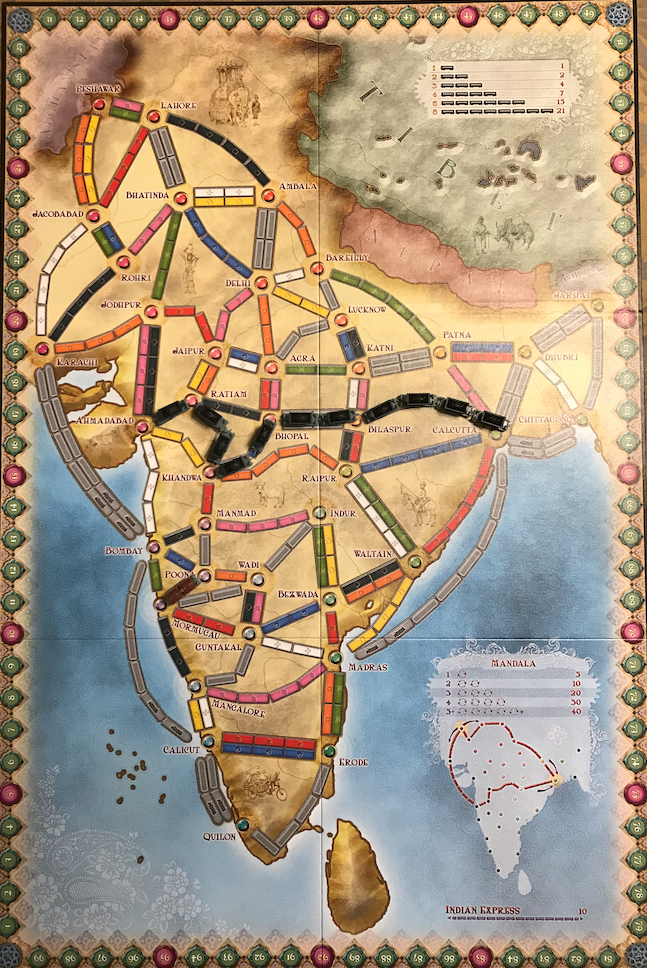
This is an odd-length route, so a brown train on a grey route specifies 18, yielding R.
Bhura (brown) is about to move from Ahmadabad to Bombay. Kali is still stuck somewhere at or before Calcutta, and Laal has not yet moved.
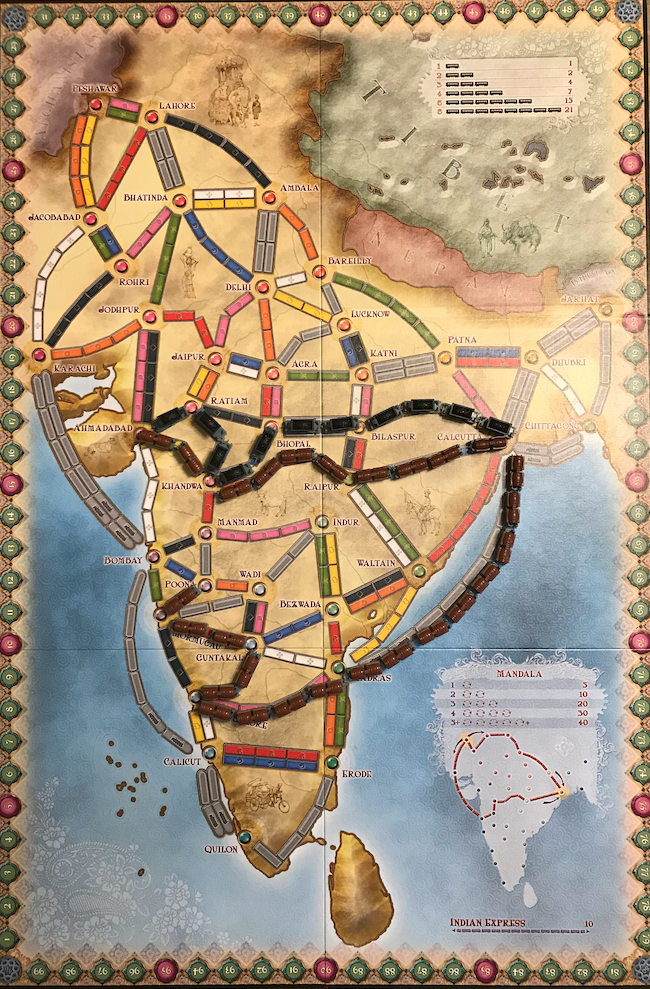
This odd-length route will be a brown train on a white route specifying 19 and yielding S.
Laal (red) is finally on the board, with Kali at Calcutta and Bhura at Bombay. He moves from Bhatinda to Rohri initially, and is just about to continue on to Karachi. Kali and Bhura will not move again until Laal reaches Calcutta.
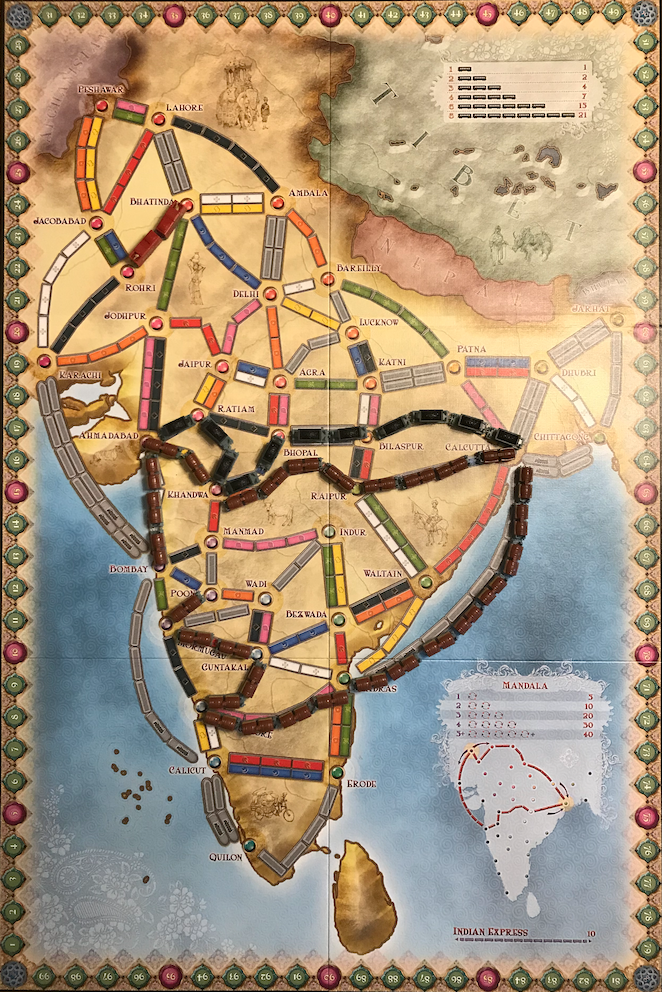
This odd-length route will be a red train on a black route, specifying 20, yielding T.
From Karachi, Laal (red) is just about to continue on to Jodhpur, while the other players cool their heels:
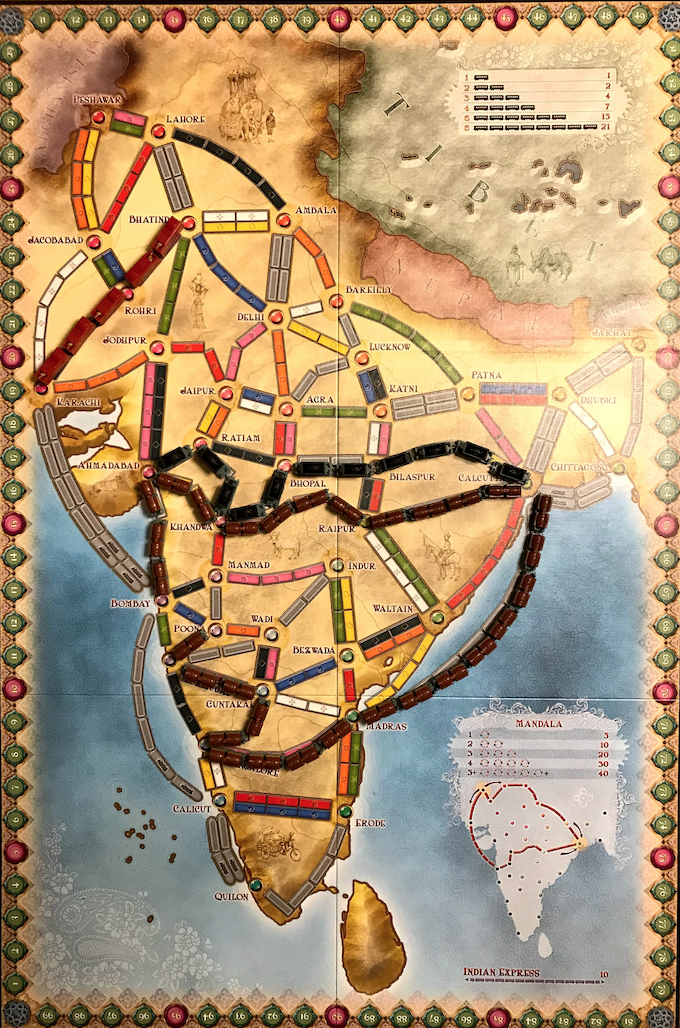
This odd-length route will be a red train on an orange route, specifying 23, yielding W.
Laal (red) continues along to the sync-up point in Calcutta, allowing the other players to move again. He has no more odd-length routes, so the order in which he moves now doesn’t matter. Let’s assume he moves all the way to the end of his journey, winding up in Bombay. We’ve moved Bhura (brown) all the way up to Karachi, where he will remain until Kali (black) gets to Lahore. Kali is now in Chittagong, about to move to Jarhat:
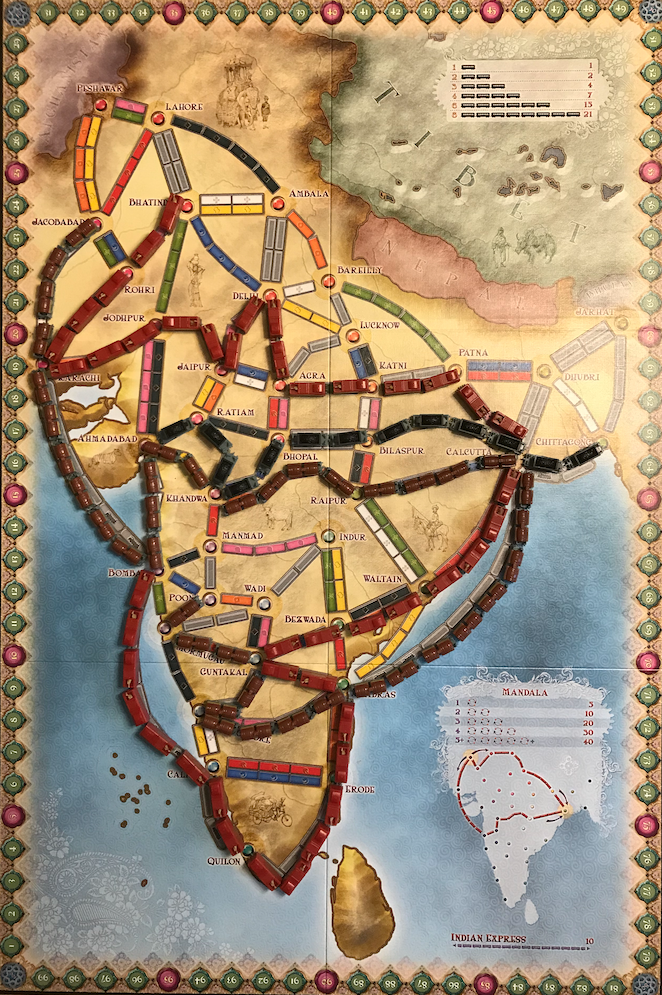
This odd-length route will be a black train on a grey route, signifying 08, yielding H.
Kali (black) moves along while Bhura (brown) sits in Karachi, waiting for Kali to arrive in Lahore. Kali is now in Bareilly, about to move into Delhi:
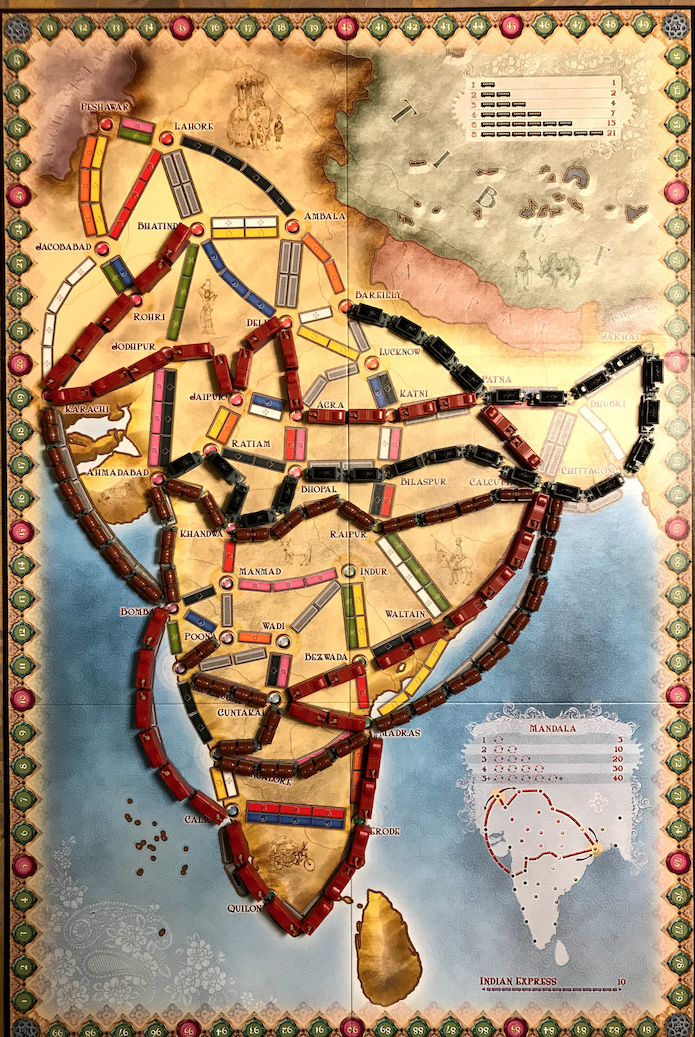
This odd-length route will be a black train on a white route, signifying 09, yielding I.
Bhura (brown) holds in Karachi as Kali (black) moves along. When Kali reaches Lahore, they both can move again. Since Kali finishes last, we will move her to just before her final route now. Bhura advances to Jacobabad and is about to move to Lahore:
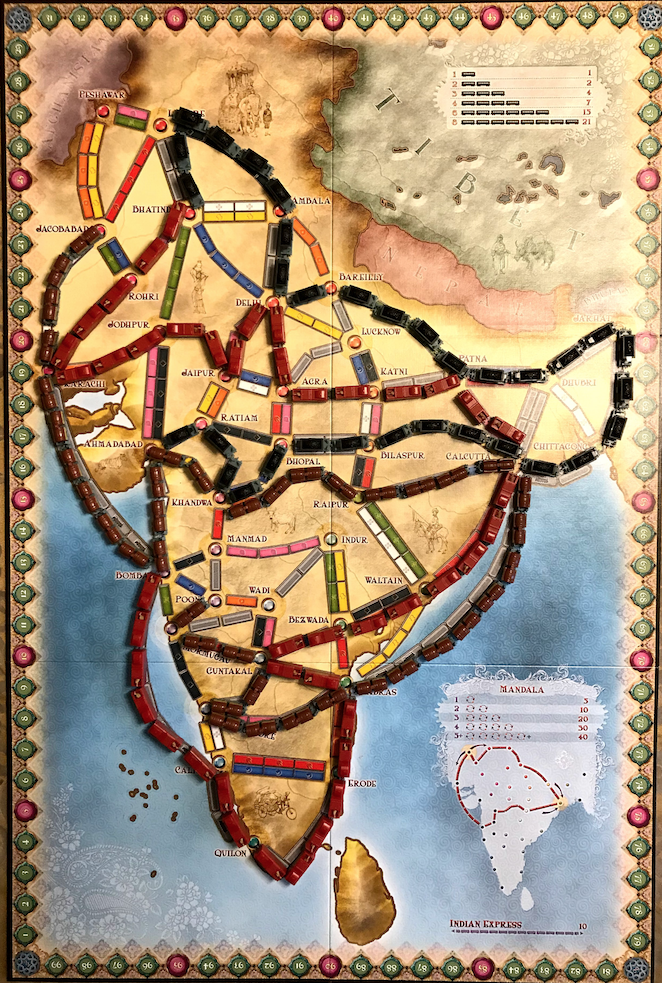
This odd-length route will be a brown train on a red route, signifying 12, yielding L.
Kali (black) is about to make the final move in the game, from Bhatinda to Jodhpur:
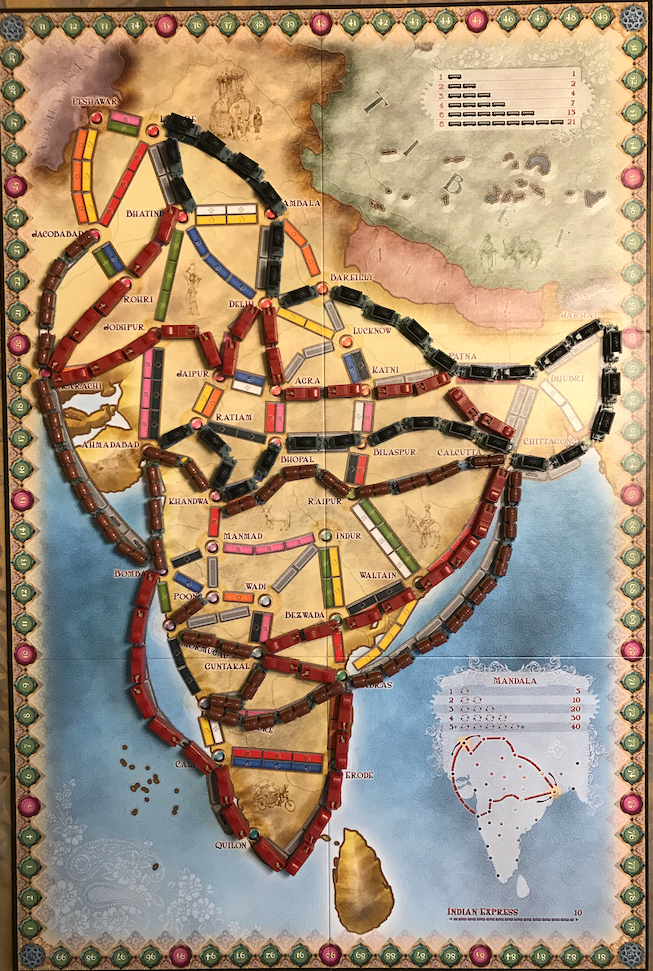
This odd-length route will be a black train on a green route, signifying 05, yielding E.
The final board position:
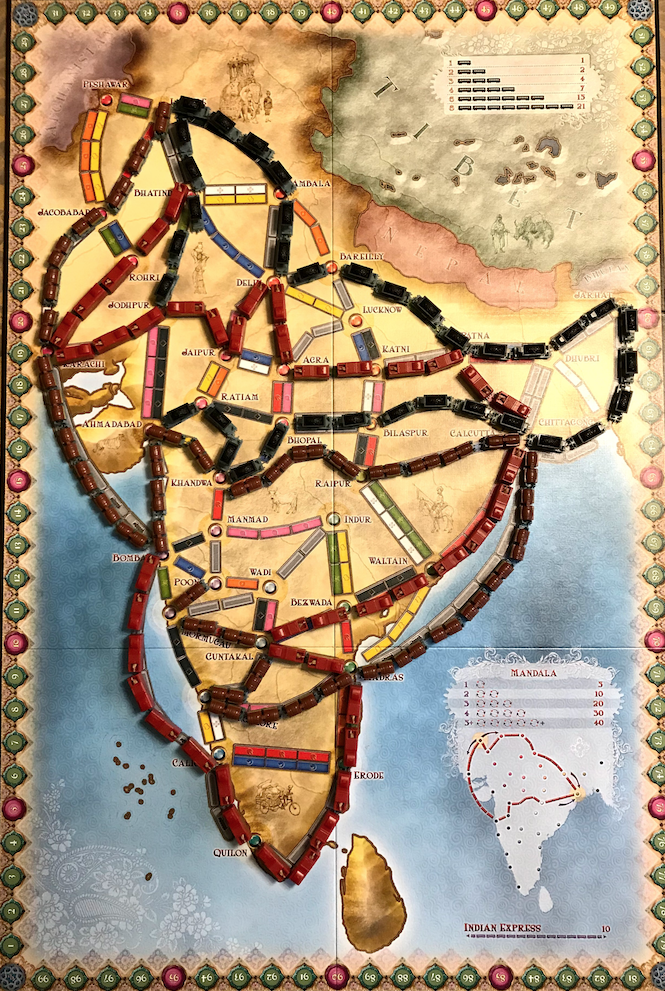
Stringing together all the letters from the odd-length routes in the order they were traversed in the game yields ERSTWHILE, the answer to this puzzle.

